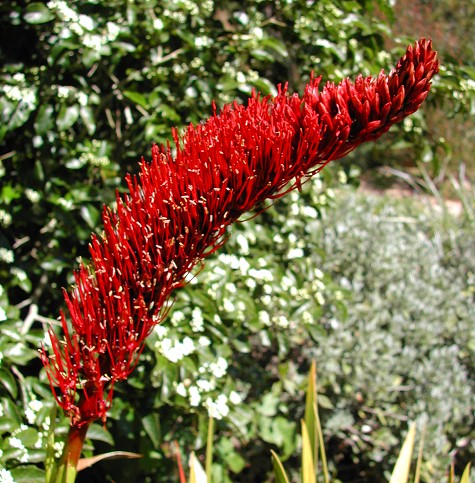Xeronema callistemon

Poor Knights Lily
There's not much information out there on growing Xeronema. The tips below are a mixture of my personal experience with it, and what i've read and heard about it. It seems that the closer one can come to matching the conditions on the Poor Knights Islands, the more success they'll have growing Xeronema. That's not say there aren't exceptions to this.
Climate -- The temperature on the islands usually stays around 55-70F during the day, and 50-60 at night (more towards the lower end in winter, and the higher end in summer). The plant can tolerate dips into the 40s, but i don't think it can survive frost. I don't have experience with it in warm temperatures here in cool San Francisco, but it might lag if temps regularly stay in the 90s and nights are warm. But that's just a guess. In a warm area, i would give it tree-filtered sun in the hottest parts of the day, and give it adequate water.
As far as humidity, it probably doesn't like very dry air. This might be a problem if you grow it indoors in an air-conditioned room.
Soil & watering -- They seem to do best in a very well-draining substrate, with regular, light watering. On the islands, they grow in cracks in the rocks, and are bathed by regular, light rainfall every couple of days (more in winter, less in summer). The problem with growing it in rocks is the chance of it drying out if you forget to water, or go on vacation. Some say the plant is drought-tolerant however that's not been my experience. They can wilt and burn if the soil dries out, and this can lead to die-back. So my recommended soil mix is: 1 part well-decomposed compost to 1 part pumice rock (or fine orchid bark, medium gravel, etc), and 1 part sand. Mix thoroughly, along with some slow-release organic fertilizer. Place a 1" layer of gravel at the bottom of the pot for extra drainage.
As far as watering, i water lightly every couple of days. Larger plants obviously will need more water than smaller ones. I'll use a moisture meter to make sure i'm not over- or under-watering. You can buy this at most garden and hardware shops for about $5. You simply stick the probe in the soil and read the dial.
Some recommend giving the plant seawater a couple of times a year, but i haven't felt comfortable trying this. On the islands, they probably are sprayed with sea mist, although personally i would dilute any seawater you give them. I do recommend mixing some kelp powder into your soil, which you can get at garden shops. Or you can water occasionally with Maxi-Crop, which is a seaweed extract that has a lot of goodness from the sea, without all the salt.
Xeronema grows slowly so it doesn't need that much fertilizer. Feed lightly every month with a complete organic fertilizer. On the islands, they're probably fed with bird droppings, which are high in nitrogen and phosphorous.
Container size -- Give it adequate root space for the first few years, so it can grow nice and large. Some say it needs to be pot-bound to flower, however i've seen them flower in the open ground. Keep in mind that pot-bound plants will need regular watering to avoid drying out. Either way, dividing the plant or removing the offshoots may delay flowering. By the way, avoid using a black pot, which can overheat the roots.
Always transplant gently, to avoid disturbing the roots. Give the plant a watering before transplanting, to hold the soil ball together.
Sunlight -- They seem to do best with mostly sunny conditions, with some tree-filtered sun during the warmest part of the day. Along the cool Pacific coast they can take more sun, although they're more prone to bleached leaves or drying out.
Your plant was grown in filtered light and should be acclimated to direct sunlight very gradually. Start it with filtered sunlight (preferred) or an hour or two of morning sun, and slowly increase that over the course of several weeks.
Propagation -- you can separate offshoots when they form an independant clump and have some of their own roots.
If you have any questions, feel free to email me.
Happy gardening!
Jeff
Strange Wonderful Things